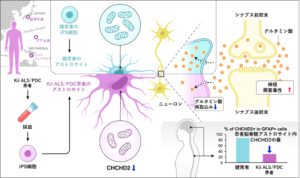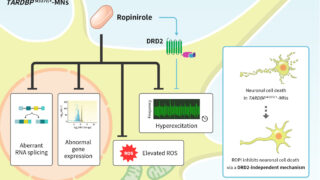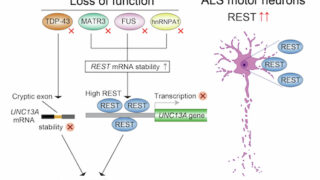Aberrant CHCHD2-associated mitochondriopathy in Kii ALS/PDC astrocytes
牟婁病(筋萎縮性側索硬化症/パーキンソン認知症複合:Kii ALS/PDC)は、紀伊半島に多発する神経難病で、筋萎縮性側索硬化症(ALS)、パーキンソン症状、あるいは認知症が同一患者さんに出現します。牟婁病では、大脳や脊髄における様々な種類の神経細胞やグリア細胞に異常をきたすことから、脳脊髄全体に分布するアストロサイトの役割が重要と考えられています。本研究では、患者さんの血液細胞からiPS細胞を樹立し、独自の方法でアストロサイトを高効率に分化誘導することに成功しました。
また、患者さんのアストロサイトを解析したところ、Intrinsically disordered protein region (IDPR)を有するCHCHD2というミトコンドリア機能に重要な遺伝子およびタンパク質の発現が著明に低下し、ミトコンドリアの減少やクリステの形態異常も伴い、神経を保護する機能が低下していることを突き止めました。さらに、CHCHD2の発現を回復する、あるいはミトコンドリア機能を改善する処置を行うことで、部分的に患者アストロサイトの機能を改善しました。
最後に、亡くなられた患者さんの脳脊髄アストロサイトにおけるCHCHD2の発現を検索したところ、当該タンパク質が減少していることも明らかにしました。
以上の事柄について、『Acta Neuropathologica』誌に報告しました(貢献内容:ヒト疾患iPS細胞モデルを用いたIDP関連病態検証と創薬)。

Abstract:
Amyotrophic Lateral Sclerosis/Parkinsonism-Dementia Complex (ALS/PDC), a rare and complex neurological disorder, is predominantly observed in the Western Pacific islands, including regions of Japan, Guam, and Papua. This enigmatic condition continues to capture medical attention due to affected patients displaying symptoms that parallel those seen in either classical amyotrophic lateral sclerosis (ALS) or Parkinson’s disease (PD). Distinctly, postmortem examinations of the brains of affected individuals have shown the presence of α-synuclein aggregates and TDP-43, which are hallmarks of PD and classical ALS, respectively. These observations are further complicated by the detection of phosphorylated tau, accentuating the multifaceted proteinopathic nature of ALS/PDC. The etiological foundations of this disease remain undetermined, and genetic investigations have yet to provide conclusive answers. However, emerging evidence has implicated the contribution of astrocytes, pivotal cells for maintaining brain health, to neurodegenerative onset, and likely to play a significant role in the pathogenesis of ALS/PDC. Leveraging advanced induced pluripotent stem cell technology, our team cultivated multiple astrocyte lines to further investigate the Japanese variant of ALS/PDC (Kii ALS/PDC). CHCHD2 emerged as a significantly dysregulated gene when disease astrocytes were compared to healthy controls. Our analyses also revealed imbalances in the activation of specific pathways: those associated with astrocytic cilium dysfunction, known to be involved in neurodegeneration, and those related to major neurological disorders, including classical ALS and PD. Further in-depth examinations revealed abnormalities in the mitochondrial morphology and metabolic processes of the affected astrocytes. A particularly striking observation was the reduced expression of CHCHD2 in the spinal cord, motor cortex, and oculomotor nuclei of patients with Kii ALS/PDC. In summary, our findings suggest a potential reduction in the support Kii ALS/PDC astrocytes provide to neurons, emphasizing the need to explore the role of CHCHD2 in maintaining mitochondrial health and its implications for the disease.
Keywords: Amyotrophic lateral sclerosis (ALS); Astrocyte; CHCHD2; Kii ALS/PDC; Mitochondria; Parkinsonism-dementia complex (PDC).
Author: Leventoux N*, Morimoto S*, Ishikawa M, Nakamura S, Ozawa F, Kobayashi R, Watanabe H, Supakul S, Okamoto S, Zhou Z, Kobayashi H, Kato C, Hirokawa Y, Aiba I, Takahashi S, Shibata S, Takao M, Yoshida M, Endo F, Yamanaka K, Kokubo Y†, Okano H†.
*contributed equally, †co-correspondence
Journal: Acta Neuropathol 2024 May 15;147(1):84. doi: 10.1007/s00401-024-02734-w.
投稿者プロフィール

- Project Associate Professor
-
Satoru Morimoto, M.D., Ph.D.
Keio University Regenerative Medicine Research Center (KRM)
Project associate professorResearch Gate Building TONOMACHI 2, 4B, 3-25-10, Tonomachi, Kawasaki-ku, Kawasaki-shi, Kanagawa,
210-0821, Japan
最新の投稿
 ノンドメインブログ2025.09.05第六節 カハールのドグマに挑む、神経幹細胞研究へかじ舵を切る
ノンドメインブログ2025.09.05第六節 カハールのドグマに挑む、神経幹細胞研究へかじ舵を切る 令和7年度(FY2025)2025.08.24Ropinirole Functions Through a Dopamine Receptor D2-Independent Mechanism to Ameliorate Amyotrophic Lateral Sclerosis Phenotypes in TARDBP-Mutant iPSC-Derived Motor Neurons
令和7年度(FY2025)2025.08.24Ropinirole Functions Through a Dopamine Receptor D2-Independent Mechanism to Ameliorate Amyotrophic Lateral Sclerosis Phenotypes in TARDBP-Mutant iPSC-Derived Motor Neurons 令和7年度(FY2025)2025.08.24ALS-associated RNA-binding proteins promote UNC13A transcription through REST downregulation
令和7年度(FY2025)2025.08.24ALS-associated RNA-binding proteins promote UNC13A transcription through REST downregulation ノンドメインブログ2025.08.24第五節 生命科学の世界への助走、Musashi発見が起爆剤に
ノンドメインブログ2025.08.24第五節 生命科学の世界への助走、Musashi発見が起爆剤に


